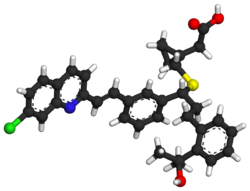 | |
 | |
| Clinical data | |
|---|---|
| Pronunciation | mon te loo' kast |
| Trade names | Singulair, others |
| AHFS/Drugs.com | Monograph |
| MedlinePlus | a600014 |
| License data |
|
| Pregnancy category |
|
| Routes of administration | By mouth |
| Drug class | Leukotriene receptor antagonist |
| ATC code | |
| Legal status | |
| Legal status | |
| Pharmacokinetic data | |
| Bioavailability | 63–73% |
| Protein binding | 99% |
| Metabolism | Liver (CYP2C8-major, CYP3A4 and CYP2C9-minor) [2] |
| Elimination half-life | 2.7–5.5 hours [4] |
| Excretion | Bile duct [4] |
| Identifiers | |
| |
| CAS Number | |
| PubChem CID | |
| IUPHAR/BPS | |
| DrugBank | |
| ChemSpider | |
| UNII | |
| KEGG | |
| ChEBI | |
| ChEMBL | |
| CompTox Dashboard (EPA) | |
| ECHA InfoCard | 100.115.927 |
| Chemical and physical data | |
| Formula | C35H36ClNO3S |
| Molar mass | 586.19 g·mol−1 |
| 3D model (JSmol) | |
| Melting point | 145 to 148 °C (293 to 298 °F) |
| |
| |
| (verify) | |
Montelukast, sold under the brand name Singulair among others, is a medication used in the maintenance treatment of asthma. [5] It is generally less preferred for this use than inhaled corticosteroids. [5] It is not useful for acute asthma attacks. [5] Other uses include allergic rhinitis and hives of long duration. [5] For allergic rhinitis it is a second-line treatment. [6]
Contents
- Medical uses
- Pharmacology
- Adverse effects
- FDA investigation
- Drug interactions
- Society and culture
- Patents
- Use with loratadine
- Brand names
- References
Common side effects include abdominal pain, cough, and headache. [5] Severe side effects may include allergic reactions, such as anaphylaxis and eosinophilia. [5] Use in pregnancy appears to be safe. [5] Montelukast is in the leukotriene receptor antagonist family of medications. [5] It works by blocking the action of leukotriene D4 in the lungs resulting in decreased inflammation and relaxation of smooth muscle. [5]
Montelukast was approved for medical use in the United States in 1998. [5] It is available as a generic medication. [7] In 2023, it was the 20th most commonly prescribed medication in the United States, with more than 25 million prescriptions. [8] [9]